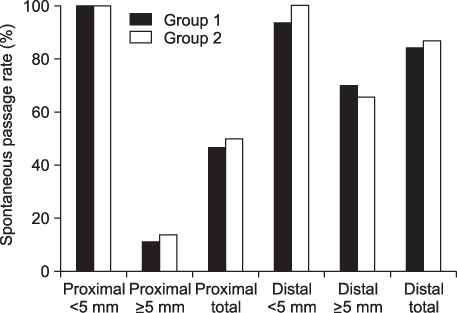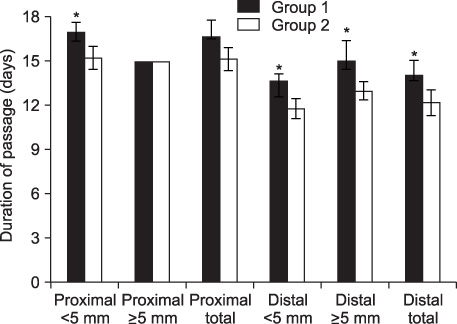Korean J Urol.
2009 Dec;50(12):1213-1218.
Effect of Tamsulosin and Dichlozid on the Expected Treatment of Ureteral Calculi
- Affiliations
-
- 1Department of Urology, College of Medicine, Kwandong University, Goyang, Korea. urokdj@hotmail.com
Abstract
- PURPOSE
We evaluated the effect of tamsulosin and hydrochlorothiazide (Dichlozid) on the expulsion of ureteral stones.
MATERIALS AND METHODS
A total of 132 patients with a single ureteral calculi less than 10 mm in diameter were enrolled and divided into 3 groups: group 1 (n=40) received tamsulosin (0.2 mg/day), group 2 (n=35) received Dichlozid (25 mg/day) and tamsulosin (0.2 mg/day), and group 3 (n=57) was the control. Proximal and distal ureteral stones were evaluated separately. Efficacy was evaluated in terms of the rate and duration of expulsion according to stone size (<5 mm, > or =5 mm) for a maximum period of 4 weeks.
RESULTS
The mean stone diameters were 4.9+/-1.7 mm (group 1), 4.8+/-1.6 mm (group 2), and 5.3+/-1.8 mm (group 3). The overall expulsion rates were 70%, 74.3%, and 52.6%, respectively, and showed statistical significance. The mean durations of expulsion were 14.7+/-1.6, 12.8+/-1.5, and 18.0+/-2.0 days, respectively, and group 2 showed a significant decrease in the duration. There were no significant differences in the expulsion rate of proximal and distal ureteral stones in any group. Distal ureteral stones in groups 1 and 2 showed a significant reduction in the mean expulsion time (<5 mm: 13.6+/-0.5, 11.8+/-0.7, and 16.7+/-0.8 days in groups 1, 2, and 3, respectively; > or =5 mm: 15.0+/-1.4, 13.0+/-0.6, and 17.8+/-0.4 days in groups 1, 2, and 3, respectively). The mean expulsion time for smaller proximal stones (<5 mm) in groups 1 and 2 was reduced significantly (17+/-0.6, 15.2+/-0.8, and 19.3+/-0.6 days in groups 1, 2, and 3, respectively).
CONCLUSIONS
Medical therapy with tamsulosin is time-saving and effective for treating ureteral calculi. In addition, adjunctive treatment with Dichlozid may reduce the duration of expulsion.
Keyword
MeSH Terms
Figure
Reference
-
1. Parmar MS. Kidney stones. BMJ. 2004. 328:1420–1424.2. Porpiglia F, Destefanis P, Fiori C, Fontana D. Effectiveness of nifedipine and deflazacort in the management of distal ureter stones. Urology. 2000. 56:579–582.3. Kim JW, Choi DY, Lee JG. Effect of tamsulosin on the expected treatment of upper and lower ureteral stones. Korean J Urol. 2007. 48:724–730.4. Choi NY, Ahn SH, Han JH, Jang IH. The effect of tamsulosin and nifedipine on expulsion of ureteral stones after extracorporeal shock wave lithotripsy. Korean J Urol. 2008. 49:150–154.5. Preminger GM, Tiselius HG, Assimos DG, Alken P, Buck C, Gallucci M, et al. 2007 guideline for the management of ureteral calculi. J Urol. 2007. 178:2418–2434.6. Yendt ER, Cohanim M. Prevention of calcium stones with thiazides. Kidney Int. 1978. 13:397–409.7. Kim TH, Oh SY, Moon YT. The effect of tamsulosin on expulsion of ureteral stones after extracorporeal shock wave lithotripsy. Korean J Urol. 2008. 49:1100–1104.8. Porpiglia F, Destefanis P, Fiori C, Scarpa RM, Fontana D. Role of adjunctive medical therapy with nifedipine and deflazacort after extracorporeal shock wave lithotripsy of?ureteral stones. Urology. 2002. 59:835–838.9. Laird JM, Roza C, Cervero F. Effects of artificial calculosis on rat ureter motility: peripheral contribution to the pain of ureteric colic. Am J Physiol. 1997. 272:R1409–R1416.10. Jang WK, Hong YK. The efficacy of furosemide-based medical expulsive therapy with tamsulosin and deflazacort for symptomatic distal ureter stones. Korean J Urol. 2008. 49:1013–1017.11. Singh A, Alter HJ, Littlepage A. A systematic review of medical therapy to facilitate passage of ureteral calculi. Ann Emerg Med. 2007. 50:552–563.12. Davenport K, Timoney AG, Keeley FX Jr. Effect of smooth muscle relaxant drugs on proximal human ureteric activity in vivo: a pilot study. Urol Res. 2007. 35:207–213.13. Weir MR, Prisant LM, Papademetriou V, Weber MA, Adegbile IA, Alemayehu D, et al. Antihypertensive therapy and quality of life. Influence of blood pressure reduction, adverse events, and prior antihypertensive therapy. Am J Hypertens. 1996. 9:854–859.14. Shin JH, Moon YT. Effects of intravenous fluid and diuretics on stone fragmentation and passage during extracorporeal shock wave lithotripsy (ESWL) of upper ureteral stone. Korean J Urol. 2003. 44:129–133.15. Porpiglia F, Vaccino D, Billia M, Renard J, Cracco C, Ghignone G, et al. Corticosteroids and tamsulosin in the medical expulsive therapy for symptomatic distal ureter stones: single drug or association? Eur Urol. 2006. 50:339–344.
- Full Text Links
- Actions
-
Cited
- CITED
-
- Close
- Share
- Similar articles
-
- The Effect of Tamsulosin on Expulsion of Ureteral Stones after Extracorporeal Shock Wave Lithotripsy
- Effect of Tamsulosin on the Expected Treatment of Upper and Lower Ureteral Stones
- Comparison and Efficacy of Low-Dose and Standard-Dose Tamsulosin and Alfuzosin in Medical Expulsive Therapy for Lower Ureteral Calculi: Prospective, Randomized, Comparative Study
- Ureteroscopic Manipulation of Distal Ureteral Calculi
- Efficacy of phosphodiesterase type 5 inhibitors for the treatment of distal ureteral calculi: A systematic review and meta-analysis



